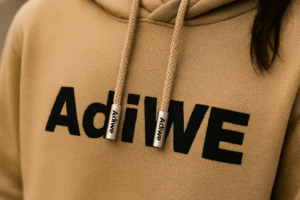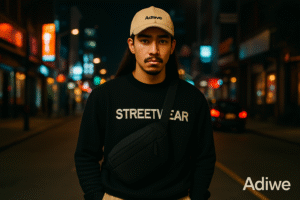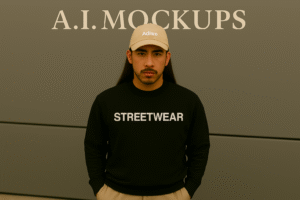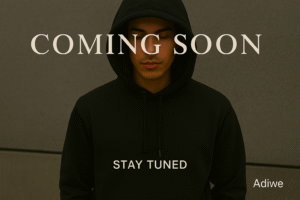Are your streetwear designs getting lost because the prints look cheap or feel stiff? Using the wrong print method can make even the best graphics crack, fade, or just not pop, hurting your brand's image. Choosing the right technique is key to making your unique vision stand out.
Screen printing, Direct-to-Garment (DTG), and Heat Transfer Vinyl (HTV) are often the go-to methods for vibrant, durable streetwear graphics. Each technique suits different design complexities, desired feels, and order volumes, offering unique advantages for bringing your brand's aesthetic to life.
Selecting the best print technique isn't just about looks; it's about matching the method to your specific design, the fabric you're using, your production quantity, and the overall quality feel you want for your brand. As a B2B manufacturer (Adiwe) working with brands like Fifty Fifty from the UK, we know how crucial this choice is, especially for achieving complex designs with high-quality results. Let's explore the best options available.
How Does Screen Printing Bring Bold Streetwear Graphics to Life?
Want those really bright, solid colors that last wash after wash, especially for larger orders? Trying other methods for simple, bold graphics in bulk might lead to prints fading prematurely or becoming too expensive per item. Screen printing delivers that classic, durable streetwear look cost-effectively.
Screen printing works by pushing ink through a mesh stencil onto the fabric, one color at a time. It's fantastic for bold graphics, logos, and text with limited colors (usually 1-6) on larger quantity orders because it's very durable and gets cheaper per piece as volume increases.
!
Think of screen printing like using a detailed stencil. We create a separate screen (stencil) for each color in your design. Then, we push ink through the open areas of the screen onto the t-shirt or hoodie. For multiple colors, we repeat the process, carefully lining up each screen.
- Why it's great:
- Durability: The ink layers bond strongly with the fabric, making it one of the most long-lasting print methods. Perfect for streetwear that gets worn a lot.
- Vibrancy: Screen printing allows for very bright, opaque colors, especially on dark garments. We can use specific Pantone colors for accurate brand matching.
- Cost-Effective (Bulk): While there are setup costs for creating the screens, the price per print drops significantly on larger runs (e.g., 50+ pieces). This is ideal for wholesale orders.
- Versatility: Works well on cotton, cotton blends, and even some synthetics.
- Things to consider:
- Setup Costs: Each color needs a screen, adding to initial costs.
- Complexity: Not ideal for photographic images or designs with many colors or gradients.
- Minimum Orders: Usually more economical for bulk orders rather than single items.
| Feature | Best Use Case | Considerations |
|---|---|---|
| Durability | Everyday wear, heavy use | Thick feel for large prints |
| Vibrancy | Bold logos, solid colors | Color count affects price |
| Cost (Bulk) | Wholesale orders (50+) | Initial screen setup fees |
| Detail | Simple graphics, text | Not for photos/gradients |
At Adiwe, screen printing is a core technique we use for many clients needing consistent, high-quality, durable prints for their main collections.
When is Direct-to-Garment (DTG) the Best Choice for Complex Streetwear Art?
Does your streetwear design feature intricate details, lots of colors, or even photographs? Trying to screen print such complexity becomes very difficult and expensive with all the required screens. DTG printing handles these detailed designs effortlessly, opening up creative possibilities.
**DTG printing uses specialized inkjet printers to apply water-based inks directly onto the fabric. It excels at reproducing highly detailed, full-color graphics, gradients, and photos, making it perfect for complex artwork, small runs, or even single custom pieces without color limitations.
- Why it's great:
- Detail & Color: Can print millions of colors, allowing for photorealistic images, complex illustrations, and smooth gradients that screen printing can't easily replicate.
- No Setup Costs (per color): Unlike screen printing, there are no screens to create, making it cost-effective for small orders or designs with many colors.
- Soft Feel: The water-based inks soak into the fabric fibers (especially on light garments), resulting in a softer feel compared to thick screen prints.
- Sampling: Excellent for creating one-off samples before committing to a bulk order.
- Things to consider:
- Fabric: Works best on 100% cotton or high-cotton blends. Printing on synthetics or dark garments often requires a white underbase layer first, which can slightly affect the feel.
- Durability: While good, DTG prints might not be quite as durable as traditional screen prints over many harsh washes, though technology is constantly improving.
- Speed (Bulk): Printing each item individually can be slower than screen printing for very large quantities.
- Color Vibrancy: Achieving super-bright colors on dark garments can be more challenging than with screen printing, requiring that underbase.
For clients with intricate artistic designs or those needing quick turnaround on samples, we utilize our advanced DTG printers at Adiwe to capture every detail accurately.
Can Heat Transfer Vinyl (HTV) Give Streetwear That Sharp, Custom Look?
Need to add crisp names, numbers, simple logos, or maybe some metallic flair to your streetwear? Trying to screen print or DTG very small runs of simple, bold designs can sometimes be inefficient. HTV offers a clean, sharp look, especially for personalization or specific effects.
Heat Transfer Vinyl (HTV) involves cutting designs from sheets of colored vinyl material and then applying them to the garment using heat and pressure. It’s excellent for bold, single-color text, numbers, simple logos, and adding specialty finishes like glitter, metallic, or flock.
The process is straightforward. First, your design (like a logo or text) is cut out from a sheet of vinyl using a computer-controlled cutter. Then, we remove the excess vinyl (weeding). Finally, the cut design is placed on the garment and pressed using a heat press, which activates the adhesive backing and bonds the vinyl to the fabric.
- Why it's great:
- Sharp Edges: HTV provides very crisp and clean edges, great for bold text and geometric logos.
- Specialty Finishes: A wide range of vinyl types is available: glitter, metallic foils, holographic, reflective, flock (fuzzy feel), and more. This adds unique texture and visual appeal.
- Cost-Effective (Small Runs/Simple): Very economical for one-offs or small batches of simple, single-color designs, as there's no screen or complex setup. Great for personalization.
- Opaque Colors: Vinyl provides solid, opaque color coverage, even on dark fabrics.
- Things to consider:
- Feel: HTV sits on top of the fabric and can sometimes feel thicker or less breathable than printed designs, especially for large graphics.
- Durability: Quality HTV is durable, but it can potentially crack or peel over time with repeated washing and stretching, especially lower-quality vinyl.
- Complexity: Not suitable for highly detailed, multi-color, or photographic designs. Weeding intricate designs can be very time-consuming.
- Layering: Layering multiple colors of vinyl is possible but adds thickness and complexity.
While not typically used for main collection graphics by brands like Fifty Fifty, we use HTV at Adiwe for specific requests like custom names on promotional items or adding small metallic details to enhance a design.
Is Sublimation Printing Suitable for Performance Streetwear?
Want those incredible, edge-to-edge, all-over prints often seen on athletic wear, but applied to streetwear? Trying to achieve this with screen printing is impossible, and DTG has limitations. Sublimation offers vibrant, permanent prints perfect for polyester-based streetwear.
Sublimation printing uses heat to turn special inks into a gas, which then permanently dyes polyester fibers. It creates incredibly vibrant, detailed, all-over prints that have absolutely no feel (zero hand), won't crack or fade, and maintain fabric breathability.
Sublimation is a bit like magic. First, the design is printed onto special transfer paper using sublimation inks. Then, this paper is placed onto the fabric (which must be primarily polyester and usually white or light-colored). When heat and pressure are applied, the ink turns into a gas and permeates the polyester fibers, bonding permanently with the material.
- Why it's great:
- Permanence & Durability: The ink becomes part of the fabric, so it will never crack, peel, or fade, lasting as long as the garment itself.
- Zero Hand Feel: Since the fabric is dyed, not printed on, you can't feel the print at all. The garment remains perfectly soft and breathable.
- Vibrancy & Detail: Achieves incredibly bright, vivid colors and sharp details, including photographs.
- All-Over Printing: Perfect for seamless, edge-to-edge designs covering the entire garment (often done by printing the fabric pieces before sewing).
- Things to consider:
- Fabric Limitation: Sublimation ONLY works effectively on high-percentage polyester fabrics (or specially coated hard goods). It doesn't bond with cotton or natural fibers.
- Base Color: Works best on white or very light-colored fabrics. The fabric color affects the final print color, so printing on dark polyester isn't really feasible.
While traditional streetwear often favours cotton, polyester blends are increasingly used for certain styles (like track jackets, jerseys, or hoodies with performance features). For clients wanting durable, vibrant all-over prints on these materials, Adiwe offers sublimation capabilities, sourcing the right fabrics for the job.
How Does Discharge Printing Create Soft, Vintage Streetwear Graphics?
Love that super soft, lived-in print feel you find on some vintage tees, especially on dark shirts? Regular screen printing inks can feel heavy and plasticky on dark cotton. Discharge printing offers a way to get bright prints with almost no feel.
Discharge printing uses a special water-based ink containing an activator that removes the dye from the garment's fabric in the shape of the design. This area is either left as the natural cotton color or replaced with a pigment, resulting in an extremely soft, breathable print.
Instead of laying ink on top of the fabric, discharge ink chemically bleaches out the shirt's original dye. Imagine using a tiny bit of bleach in the shape of your logo. We mix a discharge agent with water-based inks. When printed and cured with heat, this mixture removes the factory dye of the shirt and, if pigment was added, deposits the new color in its place.
- Why it's great:
- Ultra-Soft Hand: Because the fabric dye is removed rather than ink being piled on top, the print has virtually no feel once washed. It's as soft as the shirt itself.
- Breathability: The printed area remains breathable.
- Vintage Look: Creates a naturally soft, slightly muted, vintage aesthetic that's very popular in streetwear.
- Good on Dark Cotton: Achieves relatively bright prints on dark, 100% cotton garments without a heavy ink layer.
- Things to consider:
- Fabric Specificity: Works best and most consistently on 100% cotton garments dyed with "reactive dyes." Results can vary on blends or improperly dyed fabrics.
- Color Matching: Achieving precise Pantone color matches can be difficult because the final color is influenced by the original garment dye that's being removed. Consistency can vary slightly between batches.
- Chemical Process: It involves a bleaching agent, requiring proper handling and ventilation. The garment might have a slight odor before the first wash.
Discharge printing is a premium technique Adiwe provides for clients like Fifty Fifty who prioritize that soft hand feel and vintage vibe on dark cotton apparel, but we always recommend sampling first due to the variables involved.
Could Puff Print Add That 3D Texture Streetwear Craves?
Want your streetwear graphics to have a tactile dimension, something people can see and feel? Flat prints are standard, but they lack that physical pop. Puff print adds an eye-catching, raised 3D effect that’s become a streetwear staple.
Puff printing uses a screen printing ink mixed with a special heat-activated foaming agent. When the print is cured with heat, the ink expands and rises significantly, creating a distinct, soft, three-dimensional texture on the garment's surface.
The process starts like standard screen printing, applying the special puff ink through a screen. The magic happens during the heating (curing) stage. The additive in the ink reacts to the heat, causing the ink to expand upwards and outwards, forming a raised, 'puffy' layer.
- Why it's great:
- Unique 3D Texture: Adds a distinct visual and tactile element that makes graphics stand out. It literally adds dimension.
- Eye-Catching: The raised effect draws attention, often used for logos, text elements, or specific parts of a larger graphic.
- Retro/Fun Vibe: Can evoke a nostalgic or playful feel, popular in certain streetwear aesthetics.
- Things to consider:
- Durability: Puff print is generally less durable than standard screen print. The raised ink can be prone to cracking, flattening, or rubbing off over time, especially with rough washing or stretching.
- Detail Limitation: Not suitable for very fine lines or intricate details, as the puffing action can obscure small elements. Best for bolder shapes and text.
- Curing Sensitivity: Requires precise temperature control during curing to achieve the right amount of puff without scorching the ink or garment.
- Feel: The puffed area is obviously raised and has a unique, slightly spongy texture.
Many streetwear brands use puff print strategically to add interest to their hoodies, tees, and sweats. At Adiwe, we have the expertise to control the puff effect carefully, helping clients incorporate this popular texture into their custom designs effectively.
Why Consider Embroidery for Premium Streetwear Branding?
Looking for a way to apply your logo or design that screams quality and durability, perhaps more than print? Standard printing techniques might not always convey the premium, lasting impression you want for certain pieces. Embroidery offers a classic, high-value alternative.
Embroidery uses needles and thread to stitch a design directly into the fabric. It creates a textured, slightly raised design with high perceived value, exceptional durability, and a premium finish often favored for logos on caps, outerwear, hoodies, and polo shirts.
Creating embroidery starts with 'digitizing' the design – converting the artwork into a digital file that tells the embroidery machine where to place each stitch, what type of stitch to use, and what color thread. The garment is then hooped and placed in the machine, which automatically stitches the design with high precision.
- Why it's great:
- High Perceived Value: Embroidery often looks and feels more expensive and luxurious than printing.
- Exceptional Durability: Stitched designs are extremely long-lasting and resistant to washing and wear. The thread generally outlasts the garment.
- Textured Finish: Adds a unique, tactile dimension and depth to the design.
- Professional Look: Excellent for sophisticated branding on items like caps, jackets, and heavyweight fleece.
- Things to consider:
- Cost: Generally more expensive than printing, especially for large designs or high stitch counts. Pricing is based on the number of stitches needed.
- Detail Limitation: Not suitable for photorealistic images or very fine gradients. Small text needs to be a certain minimum size to be legible.
- Fabric Puckering: Can sometimes cause puckering or pulling on very thin or stretchy fabrics if not digitized and stabilized correctly.
- Size Constraints: Very large embroidered areas can become stiff and heavy.
Embroidery is a fantastic option for adding that premium touch. Many of our clients, including those focused on quality like Fifty Fifty, use Adiwe’s high-quality embroidery services for caps, chest logos on hoodies, or detailed badges, elevating their brand presentation.
Conclusion
Choosing the best graphic application—whether print or embroidery—depends heavily on your design's complexity, fabric choice, order quantity, desired feel, and budget. Each technique offers unique benefits for bringing your streetwear vision to life.




